 Book notes
Book notes
Book notes
 Marshes of the Ocean Shore
Marshes of the Ocean Shore
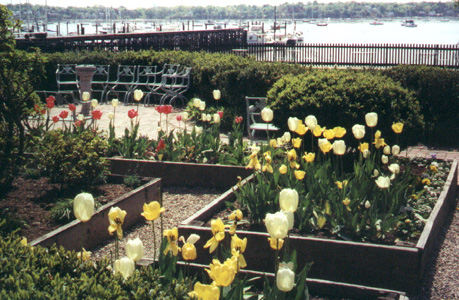
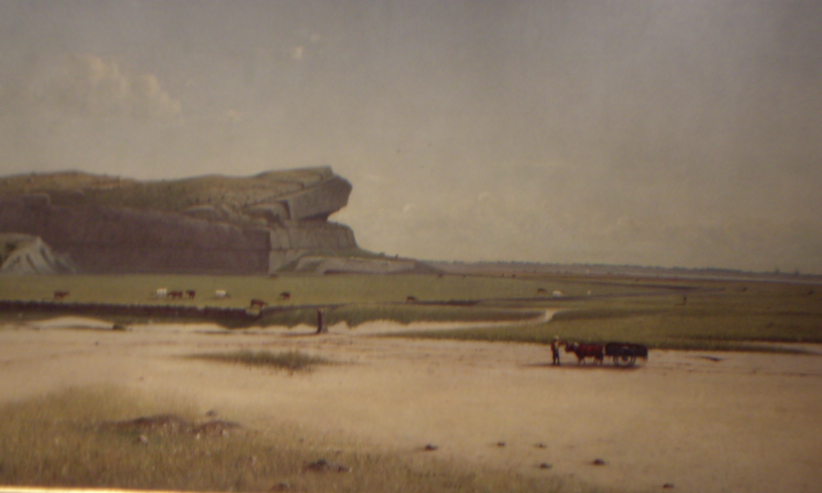
A tulip garden beside Salem harbor in Massachusetts, and a 19th century painting of the Newport Bay marshes used for harvesting salt hay.
Development of an Ecological Ethic
Analysis | Chapters | Introduction | 1 | 2 | 3 | 4 | 5 | 6 | 7 | 8 | 9
Summary | Themes | Thesis | Vocabulary | Dates | Maps :
| Boston | New York City | Connecticut River Valley | San Francisco | United States |
 A history of national attitudes from colonial times until the twentieth century concerning reclaimed or filled land reveals a tension between conservation and development. The book analyzes the origins, component concepts, and slow spread of an estuarine preservation ideal as part of a counter movement to reclamation by sustaining coastal conservation efforts because particular attention emerged that focused on water quality, health, bird, and fishery protection throughout the United States. The scientific evidence that estuarine wetlands are among the most biologically fecund communities met with resistance and disbelief despite their ecological values.
A history of national attitudes from colonial times until the twentieth century concerning reclaimed or filled land reveals a tension between conservation and development. The book analyzes the origins, component concepts, and slow spread of an estuarine preservation ideal as part of a counter movement to reclamation by sustaining coastal conservation efforts because particular attention emerged that focused on water quality, health, bird, and fishery protection throughout the United States. The scientific evidence that estuarine wetlands are among the most biologically fecund communities met with resistance and disbelief despite their ecological values.
Technology | Population | Preservation | Geographical regeneration | Law | Index to island plans
Water Quality in river mouths.
National Estuary Protection Act.
Atlantic and Pacific coastal zone ecology.
What do we mean by the productivity of wetlands?
Legal, cultural, scientific and ethical ideals applied to wetlands.
Analysis | Introduction | 1 | 2 | 3 | 4 | 5 | 6 | 7 | 8 | 9 | Themes | Thesis | Vocabulary | Dates
![]() Half of the Earth's population lives within fifty miles of the ocean shore.
Half of the Earth's population lives within fifty miles of the ocean shore.
Leading Paragraphs from the entire book
A transect is a view from water to land stretching across the marshes depicted below:
Public ownership <--- | ---> Private property
These marshes are contested ground where water mingles intimately throughout the landscapes of the shore.
| Introduction | 1 | 2 | 3 | 4 | 5 | 6 | 7 | 8 | 9 | Themes | Thesis | Vocabulary |
Ecclesiastes "All the rivers run into the sea, Yet the sea is not full.
From whence the rivers come
Thither they return again."
1. Coastal wetlands and salt marsh features of
estuaries are defined.
"A natural reciprocal nurturing of ocean and earth creates abundant wildlife in coastal wetlands. Here, salt and fresh water flow together in tidal marshes, creating rare shorelines of unsurpassed natural fertility by converting solar energy into food. Swelling tidal fluctuations recycle vital nutrients that encourage rapid vegetation growth followed by quick decay . . . . Both native and migratory wildlife thrive on the tide-mulched marsh grass fields."
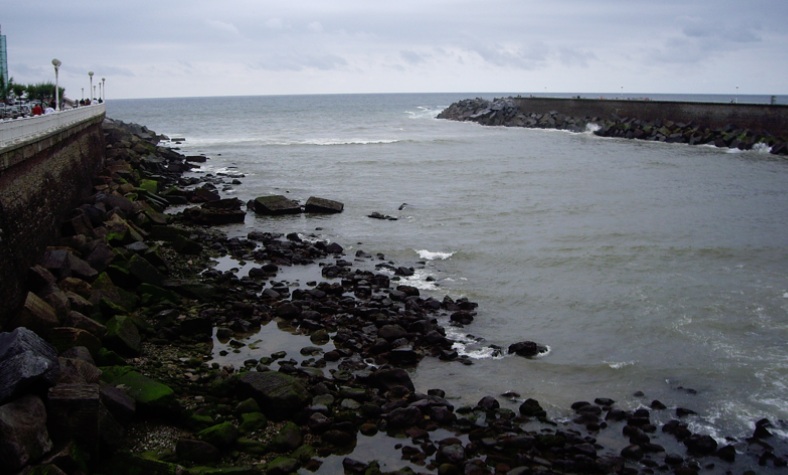
The outlet to the Bay of Biscay, San Sebastian in Spain, JVS; May, 2007.
"Coastal bodies of water where streams or rivers flow into the ocean are called estuaries."
(Siry, p. 3.)
"This study focuses on tidal marshes as parts of the estuarine system in order to explore how a more accurate and thorough scientific comprehension of matter altered conventional beliefs, legal interpretations, and government policies concerning the protection of seashores."
p.5

". . . to wade sometimes in the marshes where the bittern and the meadow hen lurk, and hear the booming of the snipe".
Thoreau in Siry, pp. 56-57.
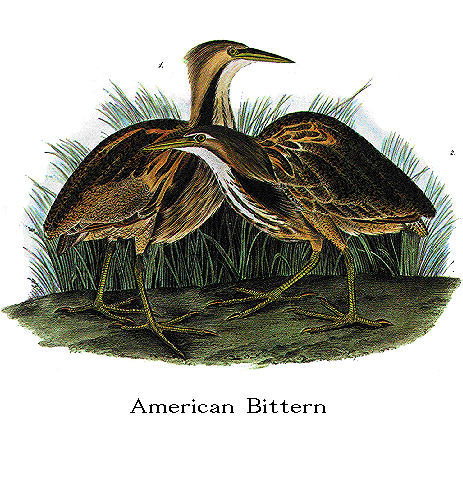 Estuaries,
or mouths of rivers as they enter the sea, are often bordered by marsh grasslands and with the unifying aspect of the ebb and flood of the tides engender a geographical unit of enormous,
historical importance because of their ecology, location, proximity to the paths of settlement and commerce, sites of cultural transformation, and numerous
–often competing– economic values.
Estuaries,
or mouths of rivers as they enter the sea, are often bordered by marsh grasslands and with the unifying aspect of the ebb and flood of the tides engender a geographical unit of enormous,
historical importance because of their ecology, location, proximity to the paths of settlement and commerce, sites of cultural transformation, and numerous
–often competing– economic values.
Where rivers are laden and lined with extensive, finely sifted, silt and mud–unlike course beaches of sand banks–the river's mouth at the sea's edge provides a chemical mixing point, shallow shoals, and regularly shifting currents to sustain numerous fisheries, bird rookeries, and wildlife because the grasses growing below and above the water harbor far more than captures the attention of the eye.
"As integral part of estuaries, tidal marshes are those portions of coastal wetlands formed by tidal action and sedimentation in certain river mouths and bays."
Depicted as:
• "divine agents of cultural restoration"
• "transformation . . . part of the ancient western dream of conquest over nature's physical forces
• "long viewed as wastelands"
• "the earth's most productive natural areas."
p. 4.
Rachel Carson taking field notes.
"Throughout the nation today a series of state and federal estuarine refuges exist as quiet testimony to the ideals, efforts and commitment of local conservation groups, planners, engineers, and scientists. These advocates possess a resolute maturity in asserting that some places must be set aside for future generations because, as Rachel Carson once remarked, 'man's way is not always the best.' "
Analysis | Introduction | 1 | 2 | 3 | 4 | 5 | 6 | 7 | 8 | 9 | Themes | Thesis | Vocabulary | Dates
"The river valleys of the Atlantic shore cut through the coastal plain, creating large numbers of estuaries, many of which are bordered by extensive tidal marshes.

An artist's depiction of Jamestown settlement in the Chesapeake Bay on the lower James River in Virginia, established in 1607.
"These coastal wetlands have been held in public trust since the original colonial grants. Unlike rights in other portions of the public domain, the public rights to fishing, hunting, and navigation on tidal lands could not be extinguished by sale to private concerns."
Review of Chapter Two's main points:
More detailed notes by paragraph on this chapter!
Atlantic seaboard counties, a map
Williamsburg, in the tidewater
This river shown here in Virginia drains the Blue Ridge Mountains down stream from the natural bridge.
Seawater has a greater density than river water,
| Seawater | river water |
|
salt
to hyper-saline |
fresh
to brackish |
|
33
parts / 1000 of NaCl |
less
that 3 to 5 parts / 1000 salt water |
|
weak,
electrically charged |
|
|
Chlorine
content is higher |
calcium
content is higher |
|
stores
carbon dioxide |
caries
phosphorus & nitrogen |
Concentration of the densest native American populations.Earliest landing sites of European occupation.
Coastal areas and food
Native American ritual for use of resources
Florida, April, 1513Two opposing views of the Chesapeake Bay marshes.1524, Verrazano & the bays located along the Atlantic coast were the sites he found that are "commodious and delightful."
Arthur Barlowe's descriptions and John White's paintings
1609 Henry Hudson expedition to New York Bay
Captain John Smith
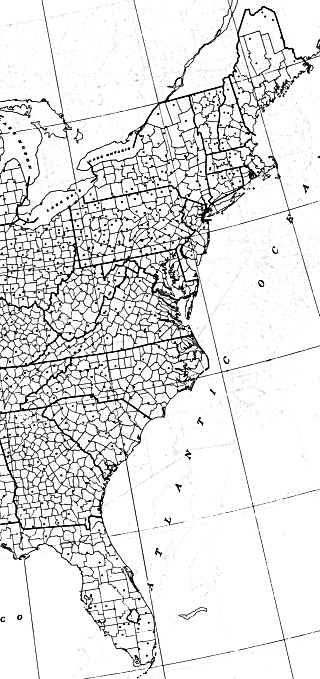
Ship worm infestation made the use of estuaries essential to ship maintenanceNew EnglandRobert Beverly's history of Virginia
Extent of Southern coastal swamps thwarted attempts to drain and reclaim coastal wetlands.
Export or cash crop agriculture developed based on slaves.
11/29/1641 Wharf needs for shipping in Boston; by 1645 mills and wharfs at Faneuil Hall Square.Boston 1663 - 1710 and the creation of Long Wharf
Water bailiffs were appointed in Boston and are examples of communal control to assure residents access (rights of all citizens) to bays for fishing and fowling.
"filling of tidal wetlands furthered maritime success." Navigability of waterways as a common interest.
Dutch in New Amsterdam, huge and diverse numbers of edible fish.
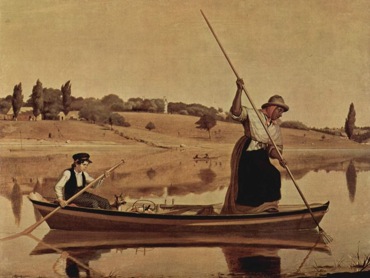

19th century paintings of fishing and hunting as wetland dependent uses of New York and New Jersey coastal marshlands.
Filling of Eastern Manhattan – large sections of lower Manhattan were reclaimed from the Bay, the North (Hudson) and East Rivers.
This is how much of Manhattan was filled in by reclamation since the 1700s.. See New York Public Library [maps collection].
Pre industrial Urban Landscapes
European attitude & Matthew Hale marshes show a lack of ambition.
1645 first ladle dredger used in Holland for reclamation -- or converting water logged and submerged land into dry land.Colonial agrarian economy of grazing and plantation crops demanded wharfage facilities in tide landsUsing technology to overcome natural hazards, obstacles and nuisances.
Opposition, fishers and fowlers; the Lord of the Fens, Oliver Cromwell. "lay dry the land."
Thomas Gilpin -- Quaker merchant, as an example of canal financier.The sheer size of Atlantic seacoast swamps inhibited American's from altering them to any great extent before the use of steam engines.
Atlantic coastal wetlands were of a greater extent and contained larger masses of water than Europe's coastal marshes, except for the Netherlands and the mouth of the Rhine in Belgium.
Britain during the time of James the first and Oliver Cromwell began to drain and reclaim a vast low lying landscape called the fens, at the mouth and along the tideland of the Great Ouse River.
Much as the British had begun in the 17th century north of Cambridge and Ely, the drainage of the Fen's by James I and the Dutch engineer Vermuyden, became a symbol of "beneficent" transformation. That was, the signal for a society to turn wet and injurious lands that stood as obstacles to good farming practices, into productive pasture and agricultural tillage.
In North America, where possible, wetlands were drained or "reclaimed" from the water in order to make them arable – or useful to agriculture or for access ways to and from canals or ports.
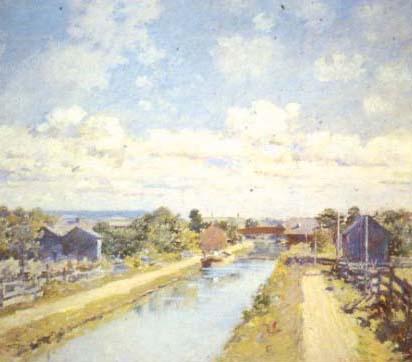 Dominant
activity of 18th century and early 19th century was canal building.
Dominant
activity of 18th century and early 19th century was canal building.
Canals were limited by both expertise and capital investment.
Science made practical through application influenced American attitudes promoted by Benjamin Franklin, Cadwallader Colden, and Adam Seybert.

 |
 |
|
Benjamin Rush and the Philadelphia, Yellow Fever epidemic of the 1790s |
||
Carl von Linne and the idea of a balance of natural harmonies, used the term and popularized ideas associated with The Economy of Nature.
American Philosophical Society's meetings on the cause of the typhoid, yellow fever, and cholera epidemics (later in 1800s) led to a discussion of the drainage and healthy transformation of swamps.
Dr. Adam Seybert, contrarian view that bad air and bad places like marshes are needed to balance out good places.
Marshes as repositories of a balancing element, though unknown at the time, to Seybert and his colleagues.
Some suggested keeping the marshes flooded at all time, to forestall the putrefaction, while the opposite idea was to drain them and plant them with crops as was and is done in the Netherlands.
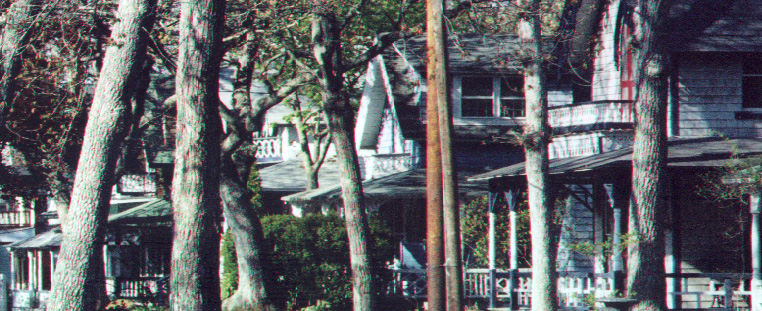
Cottages on Martha's Vineyard as examples of an urban retreat from seaside commercial development. (JVS, 2002)
Urban commercial development and agricultural expansion ran counter to Seybert and were typical of early American attitudes.
The necessity of marshes was eclipsed by dredging and reclamation to turn wetlands into agricultural dry land.
"The creation of a seaside agrarian environment..."
p. 33

"Even prior to the nineteenth century the necessity of marshes was disregarded in favor of a continued reliance on estuarine dredging and coastal reclamation.
As The image of the garden symbolized the eighteenth century intellectual recognition of humanity's role in taming and cultivating wild landscapes, the creation of a seaside agrarian environment encouraged the replacement of swamps and marshes with diked meadows or farmlands.

Marshes were not revered, nor thought of as possessing inherent value as wetland, but were regarded as commons.
Urban growth, too, fostered dumping, drainage canals, wharves and commercial shoreline development. As diseases repeatedly swept the crammed and dingy tidewater cities, the pastoral image of the garden became a paramount influence on scientists and writers, relegating noxious and obstructing coastal wetlands to a role as inefficient backwaters."
(pp. 32-33.)
Analysis | Introduction | 1 | 2 | 3 | 4 | 5 | 6 | 7 | 8 | 9 | Themes | Thesis | Vocabulary | Dates
Review | Key Players | Significant Idea | Martin J. Heade | Summary
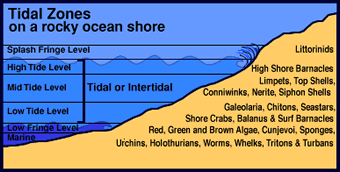 "Tidelands, however, represented
a complex problem of public administration depending on The coastal territory
in question. The proprietary responsibility for these wetlands that had existed
in The colonies was derived from The crown, to be held in perpetual trust for
The promotion of navigation and The public privileges of fishing and hunting."
"Tidelands, however, represented
a complex problem of public administration depending on The coastal territory
in question. The proprietary responsibility for these wetlands that had existed
in The colonies was derived from The crown, to be held in perpetual trust for
The promotion of navigation and The public privileges of fishing and hunting."
 U.S.
Land System, 1785, was enabled by new surveying instruments and a desire to
create a logical, repeatable, and simple system of land designation that has been
referred to as "Jeffersonian rationalism" after Thomas Jefferson's belief
in reason and utility as the twin bases for a responsible republic of small landholders.
U.S.
Land System, 1785, was enabled by new surveying instruments and a desire to
create a logical, repeatable, and simple system of land designation that has been
referred to as "Jeffersonian rationalism" after Thomas Jefferson's belief
in reason and utility as the twin bases for a responsible republic of small landholders.
Swamplands Acts made reclamation a national priority by grants to states.
Reclamation meant recovery of submerged land into dry land for farming or habitation.
In the arid west reclamation meant brining water to desert lands.
Free land in the west due to the Homestead Act.
As national policy, the lands of the public domain were sold at auction until the 1840s when growing popular support for free land in the west led to a twenty year political struggle to allow settlers to live on public lands and eventually claim them as their own property. During the Civil War this movement culminated with the passage of the "Homestead Act" granting free land to any settlers on the public domain in western territories. Like the photograph above of the southern Great Plains, lands were surveyed in a grid pattern and citizens were allowed to settle, work and claim 640 acres, or a section (1/36th of a square mile).
With the prevalence of free land in the west, why then, was land reclaimed in coastal areas?
Marshes were seen as areas of bad or impure air and hence the disease of malaria (mal + aria; bad or unhealthy + air) was blamed on standing water, putrefying in un-drained and low lying swamps that produced tainted air filled with "bilious affections."
Review of Chapter Three's main points:
"drainage and dredging costs" are associated with reclamation and the coming of the steam engines reduced these expenses by mechanization. As a consequence reclamation of wetlands became more widespread.
Protection of navigation became paramount with the creation of the Articles of Confederation, the constitutional conventions and the Constitution of 1789.Agrarianism was the ideology based on French physiocrats thought and became the ethos of Jeffersonian democracy in America based on small farms.
In early America artists, writers and naturalists began to agitate for coastal sanctuaries.
A view of New York City from New Jersey, the west side of the Hudson River.
Decline in the yields of oyster, shad and salmon fisheries.
E. I. Dupont commented on the utility of causeways over extensive marshes to advance land transportation.
Oliver Evans, steam engine as a means of draining land.
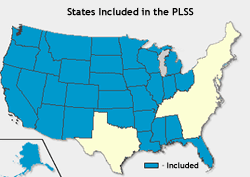
Land Ordinance of 1785 legitimated surveys and the township and range system in these states shown above as public land states (PLSS). The land surveys done in these western territories and later states –the rationale off which is depicted in the graphical display below– were based on surveying for all lands in the Public Domain, the blue states above.
Once surveyed the land was recorded and mapped to be later auctioned by the U.S. Land Office.
"the Public Domain represented all the lands ceded by Atlantic Coastal states to the federal government in 1785 by Act of the Confederation Congress. This meant the law had to be supported unanimously by all representatives of the 13 states.
The land was originally claimed by "tidewater states" along the seaboard and was carved out of these claims to vast areas west of the Appalachian mountains.
By law, the land was to be surveyed in a uniform pattern called a "grid"--or checkerboard square design-- based on the land patterns
shown in the above photo and graphic to the right.
Dry land and relatively flat topographical surfaces, or rolling hills as found along the tidewater, lent itself to such a repetitive survey system. But riparian lands along a river, or wetlands along bays and river shores were quite another challenge for the "Township and Range system," shown here, and adopted throughout the United States, as a consequence of the land ordinance of 1785.
Sections number 8, 11, 26, and 29 in every township were reserved for education, sales of which went into a fund for schools.
For examples of the impact of this system see 1: southern Great Plains and 2: the Colorado River Valley.
"Tidelands,.. represented a complex problem of public administration...."
as a coastal commons, in that everyone can gave access to the tidelands
Jefferson's influence denying fishery subsidies
US Coast Survey established 2/10/1807
Commercial advantages from navigation and canal building
Boston, the Charles River and Back Bay for
commercial reclamation and milling

Boston's Back Bay was a wetland, filled by 1830, in a repeated series of reclamation efforts.
The Jersey shore became a focus for recreation in the Jacksonian era led to widespread changes in a much larger nation.
Descriptions of recreation by "the seashore" appeared in William Cullen Bryant's publication of "Picturesque America"
New York Public Library collection
Ambivalence of attitudes about coastal wetlandsWilliam Bartram's travels
Florida and the Carolinas in 1765
Art depicted a need to vanquish the terror filled seas Washington Allston and Winslow Homer
Science and policies of the early RepublicThomas Cole, Mount Desert Is. Maine
Rugged seashores such as this were scenic magnets drawing artists and visitors alike to the seashore where coastal wetlands were considered noxious impediments and scenically less striking until later in the century when Childe Hassam and Martin Johnson Heade found artistic merit in depicting marshes.
Byron's poetry
"Roll on, thou deep and dark blue Ocean – roll!
Ten thousand fleets sweep over thee in vain;
Man marks the earth with ruin – his control
Stops with the shore; -- upon the watery plain
The wrecks are all thy deed, not does remain
A shadow of man’s ravage, . . ."Astor and the filling of Manhattan, see the lower tip of this British map comparing the shoreline in 1661 and in the 1900s, [click on map for larger version].
The map of Manhattan and the view from the Hudson River of preindustrial New York City on lower Manhattan Island
Dr. Samuel Latham Mitchell, early conservationist
A more sophisticated appreciation for coastal geography was emerging.John James Audubon and painting birds; he made the national bird life a symbol of cultural identity and a recognizable image of national pride.
Edmund Ruffin and vegetation changes of forests on the North Carolina outer banks discovered vegetational succession of plants that held the dunes and led to an eventual pine forest becoming established in the stabilized sands.
Henry David Thoreau, Cape Cod as a geological, ethnographic and biological study: landscape was to be understood as a unit from the:
- geological, to the
- climate and precipitation, to the
- vegetational and
- to the animals, birds and fishery life attracted to the areas by the water and ample nesting, feeding and breeding or spawning grounds.
Nature had a pattern that was determining as far as wildlife, fisheries and settlements were concerned.
He suggested every town keep a forest of 500 acres for the support of its needs since trees were a source of medicines, fuel, charcoal, and building materials.
"marshes candid, simple and free" (fertility)He painted how the light plays across the marshes of a seascape.
Approaching Thunder Storm, 1859
Note on Heade:
Painted mainly during the 1860s, Heade’s views of the salt marshes near Newburyport, Massachusetts are regarded among the finest works of the artist’s oeuvre. In canvas after canvas, Heade took the same basic elements—haystacks, flat marshland, a glassy river and open sky—and arranged them in different ways to arrive at various harmoniously-balanced horizontal compositions. Heade’s careful planning resulted in pleasing, geometrically rigorous paintings whose sense of order is not only aesthetically satisfying, but imbued with pertinent meaning as well. For a nation torn by civil war, Heade’s salt marsh landscapes offered on one hand the simple balm of serenity and on the other, a vision of nature inhabited by an orderly and benevolent Deity in which only the passing rain cloud alludes to the nation’s troubles.
Analysis | Introduction | 1 | 2 | 3 | 4 | 5 | 6 | 7 | 8 | 9 | Themes | Thesis | Vocabulary | Dates
4. Commerce and The Public Trust
Review | Key Players | Significant Idea | Summary | recurrent idea
National sympathy for protecting nature dramatically appeared among elite professionals before The Civil War. These preservation advocates conceived The intellectual and tactical foundations of future federal resource protection policies -- especially for fisheries, wildlife, land and water.
Landscape renewal of Marsh; allied with Olmsted, Waring, Ellet, and Powell, after Ruffin.
New England, the Connecticut River, tidewater Carolinas, The nation's cities, and the Mississippi River as places that triggered a need for "renewal."
The Connecticut river's watershed run's through so many states that the competing jurisdictions with different regulations had disrupted the migration of salmon and other ocean and river dwelling fisheries. Thomas Cole's Oxbow painting of a bend in the Connecticut river.
Agencies of renewal and regeneration
Geographical regeneration, or the "restoration of disturbed harmonies," were Marshes' ideas concerning what needed to be done to protect natural values inherent in land, air and water.
Review of Chapter Four's main points:
Two early and two additional characteristics of national preservation movement 1850-1870; fish propagation and urban parks, then scenic monumentality and restoration of the natural environment all formed the "intellectual basis of the 20th century conservation movement."
Overview of important theme:
the emergence of an organic, systemic and biocentric vision of protection.
1864 George P. Marsh, Man and Nature
Origins of fish and bird preservation,artificial fish propagation
Lake Merritt estuary protection in California, 1870.
Key reiteration of the protectionist philosophies in the development of a conservationist impulse derived from the original preservationist perspectives
What are the underlying differences?
p. 64.
Shades of green of two interest groups who are not that far apart.
| preservationist | conservationist |
| traditional | utilitarian * |
| scenic beauty | irrigation surveys |
| biocentric | utilitarian |
| recreation and contemplation | reclamation and reservoirs |
Biocentric, or life-centered approach to protecting fish and bird habitats
oikology (1866) invented by Ernst Haeckel -- a German Darwinian scholar based on Darwin's (1859) distinction between the organic and inorganic conditions of existence.* Utilitarian is the greatest good for the greatest number; in conservation it means the wisest use for the largest number of users over the longest period of time.
Federal surveys began before the war but burgeoned after the war, rivers, fish, birds, geology.
Addison Verrill described fresh, brackish, and salt water fish.Environmental ideal of fish and (bird) wildlife protection.
John Marshall's Gibbons vs. Ogden decision, 1826
Colonial wildlife preservation
Santa Rosa Island, Florida utilitarian conservation of live oak trees and forests for naval shipbuilding and defense. (1828)
Tidelands as a public trust for purposes of navigation, fishing and hunting.
Hydrodynamics of sediment: as the river rises the water moves more dirt and gravel causing a scouring out of mud (the mud is displaced) and the river channels are blocked with silt. This requires more expenditures for channel maintenance to keep the streams navigable, and open for shipping.The legal opinions of the public trust doctrine and inalienability of submerged lands combined to create a new basis for federal intervention in river conservation.
Federal and State sharing authority
Common benefits of navigable waterways.
• Public domain defined as federal lands & waters
• tidelands are sovereign lands held in trust by states.
Floodplains, flood and overflow lands, river swamps.
Swamplands acts, 1848-1850: made reclamation or drainage and levee building a federal priority.
Mississippi River oxbow
The drainage of upland and upriver swamps through settlement and reclamation aggravated flooding down river.
Decline in fisheries.
Charles Ellet and the 1852 Mississippi River Survey.
Ellet had a watershed and multi state perspective to solve the river's siltation and flood problems.technological remedy to correct the impacts of settlement, policy and bad laws.California rivers had similar problems of flooding and greater silt and sediment deposition.
Levees were essential to prevent flooding on the Sacramento River.
Levees required coordinated efforts which were often lacking.
Cholera epidemics swept through in 1832, 1849, & 1866, pointed up bad water quality in wells contaminated by animal and human excrement
Flood control planning and public health protection required a comprehensive view.Olmsted and organic constraints of urban and wild parks: NYC & Yosemite.Frederick Law Olmsted Sr. (landscape engineer) and George Waring (sanitary engineer) had such a vision for improving the health of cities.
Urban parks and sanitation reform both advocated a communal vision.
Technology of sewers, parkways and parks was the instrument of civic rejuvenationRecognized the need to engineer in order to restore "disturbed harmonies" induced by population, settlements, industry and waste.George Waring and sanitary engineering as a civic necessity and a moral duty to protect public health.
State police power to protect and promote public health
George Perkins Marsh, local Vermont and New England diplomat with an international sense of place than make geography essential to a well-educated citizen.
Marsh, Man and Nature, 1864, was a pioneering work on how humans alter the geography often to their own demise.
Marsh, Ruffin, Ellet and Olmsted form a powerful organic approach to understanding human impact on natural features and the limitations these impose on societies.
"Marsh's appeal for geographical regeneration significantly altered the attitudes of specialists toward land legislation, river policies, and wildlife conservation laws.
"Their ideas reflected a systemic understanding of land as a series of biotic communities, and these ideas appeared before such attitudes were commonplace among scientific specialists."
p. 82
Analysis | Introduction | 1 | 2 | 3 | 4 | 5 | 6 | 7 | 8 | 9 | Themes | Thesis | Vocabulary | Dates
"After The War between The States, the doleful predictions of George Perkins Marsh concerning fisheries and estuarine habitats churned in the mind of his confidant and supporter, Spencer Fullerton Baird. As a naturalist and assistant director of the Smithsonian Institution, Baird knew that sport and commercial fisheries were dependent on anadromous fish. These fishes lived most of their existence in the sea but required the freshwater river sources to spawn the next generation of salmon, herring, or shad. Often the juveniles of these species lingered in the estuaries, where a rich supply of food, nourished the young."
John Quincy Adams , President and later Member of the House of Representatives when it created the Smithsonian Institution.
George Perkins Marsh, scholar and diplomatReview of Chapter Five's main points:Alexander Agassiz, Oceanography
Spencer Fullerton Baird, US Fish Commission
M. F. Maury, oceanography and climate
C. Hart Merriam, "life zones"
Fishing and hunting interests before the war influenced Post Civil War Preservation impulses.
Oyster fisherman's plight pointed up the need for federal intervention.New Federal Bureaus like the Smithsonian Institution (1846) & Department of the Interior (1849).Baird's U.S. Fish Commission (1871) drew heavily on the naturalists and the natural history tradition.
Lack of Congressional support for government science.Alexander Dallas Bache (1842) transformed the US Coast Survey.John Quincy Adam's Internal Improvements drew opposition despite the obvious needs.
Coastal fortifications and mapping
Jacksonian creation of the US Coast Survey, 1832.
Navy Depot of Charts and Instrument 1842, and Naval Observatory.
Lt. Matthew Fontaine Maury and the US Exploring Expedition.
Maury, 1851, new global map of Winds and Currents.Habitat science in coastal studies, Manx naturalist, Edward Forbes described zone by depth.Physical Geography of the Sea, by Maury, based on Humboldt and Goethe's influences.
Military (Maury) & civilian (Bache) rivalry, notwithstanding yielded valuable natural history of the nations' and world's seashores.
Biological and geographical information about seashores, currents, tides and fisheries grew.
Specialists began to replace the naturalists (generalist) in government science.
National Academy of the Sciences, NAS, (1863) marked the ascendancy of specialists.
Specialists in federal sciences.
Niche was defined by naturalists as routine place of residence and occupation of means of extracting a living, securing a living in the economy of nature.Alexander Agassiz, in 1865, published Seaside Studies in Natural History, He and his mother Caroline collaborated having described coast habitats of sandy beach, rocky shore, and mud flat.Alexander Agassiz popularized the works of Dana, Forbes and Gosse to a wider audience.
Forbes described zones of depth and Gosse described Devonshire coastal marine life.
Louis Agassiz of Harvard was an important marine and fresh water scientist of invertebrates.
His influence was felt through his students, his Museum of Comparative Anatomy & his summer school to study seaside biology.
Louis Agassiz was a curious mix of modern (Ice Age) and antiquated (anti-Darwinian) ideas.
Louis Agassiz described the coral reefs along the Southeastern Florida coasts (1850s).
Alexander Agassiz described the organic realms of seaside creatures in zones, after Alexander Von Humboldt's Torrid, Temperate and Frigid zone classifications.Agassiz oceanic zones were remarkably accurate.
Substrate (shore materials, rock, sand, mud) were described as restricting certain life forms.
A. Agassiz recognized the favorable conditions of tropical Florida reefs to rich and varied fauna.
Spencer Fullerton Baird was more of a naturalist later influenced Fish Commission & Biological Survey, hired C. Hart Merriam there at the U.S. Biological Survey.
Line vs. trap fisherman argued over the causes for New England's coastal fishery decline 1870.
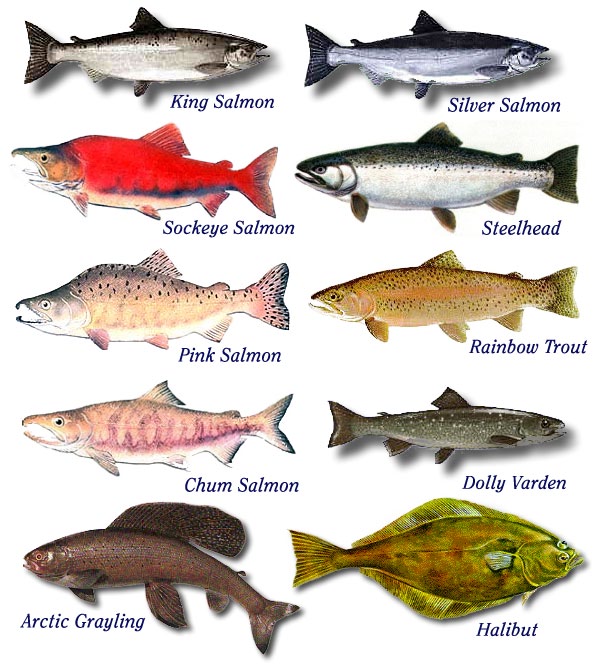
US Fish Commission created to resolve such disputes by looking into the science.
Fishery conservation was the first institution to promote science based protection policies at the federal level.
Dams were destroying river fisheries laws well as coastal.
Lumber and mill interests opposed fishery conservation.
Fish hatcheries were promoted along with fishery science.
B. The US Fish Commission brought national attention to European Science.
Bird protection emerged in Federal science bureaus.Karl Möbius's discussion of an Oyster Reef as a single entity or biocoenosis (biotically functioning assemblage) or biocenose
"the entire . . . community would be transformed." by changes in external conditions.
Ernst Haeckel's contributions to nomenclature and evolution.
C. Hart Merriam's concept of Life Zones applied to San Francisco Mountains, in the Sonoran desert.

As you move up a mountain it is similar, with respect to vegetation, to moving towards the poles, from: tropical, to temperate, to frigid zones.
Each zone is characterized by distinctive types of dominant plants, unseen bacteria, necessary fungi, resident and migratory animals.
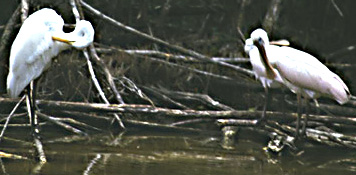
Bird conservation due to fashion and the millinery trades. State Audubon societies.1891, Forest Reserve Act, protected watershed values of western timber lands.
Afognak Island, Alaska set aside as a fish, wildlife and bird refuge in 1892.
First introduced in 1897, the Lacey Act of 1900 used Interstate Commerce to stop bird hunting, halting the shipment of avian skins killed in violation state laws.
John Wesley Powell, Comprehensive land-use plan for the arid regions 1878.
For example: Barrier islands are neither barriers nor permanent but move and are moving linear ribbons of momentarily trapped sands.
Frederick H. Newell (1902) Bureau of Reclamation -- for arid and maritime lands.Eugenius Warming, plants were classified in terms of water tolerance, halophyte vs. xerophyte; halophyte meaning salt loving plants and xerophyte meaning dry loving plants.
Shaler nonetheless recommended reclamation of coastal marshes in the belief that these well watered soils would produce needed agricultural crops in nearby growing cities .Shaler's recognition of marsh's as a place of "abundant development of animal life."
p. 107.
Charles Van Hise and economics of land and land ownership, believed in individual home ownership as a means of improving the well-being of the community.
"waste places" of marshes required drainage.Organic approach to federal policy making is a thread and theme from 1871-1907.Full agricultural potential demanded reclamation --to bring or remove water-- of "wasted" land.
Pelican Island, 1903, reserved in Florida (Sebastian Inlet).
Mcgee and Pinchot crafted Comprehensive Riverine Management.
River conservation was multipurpose: flood, wildlife, navigation and reclamation.
Reclamation of wetlands meant their drainage and removal of the excess water, while in arid regions reclamation meant to bring river and ground water to parched earth so that irrigation could be used to bring the needed water to crops, orchards and settlements alike.
"...remarkable rebuttal of laissez faire political economy.
"Somewhat ambivalently, tidal marshes had been recognized as essential habitats for fish and fowl while still being viewed as wastelands – after 1890,they were seen as a surrogate frontier of reclaimable farmland and homesteads to fulfill the popular promises of Progressive political and social ideology."
p. 111.
George Perkins Marsh: conservationist.
Analysis | Introduction | 1 | 2 | 3 | 4 | 5 | 6 | 7 | 8 | 9 | Themes | Thesis | Vocabulary | Dates
6. The New Ecology and The New Ecological Ethic
"At the turn of the century ecology and economics agreed on the classification of tidal marshes as obstructing wastelands. Resource economics determined the 'best' use of land solely from human and utilitarian perspectives. The initial findings of terrestrial and marine biologists supported policies to make human 'improvements' over nature's perceived inefficiency. However, in The 1930s and 1940s a number of scientists, including wildlife biologist, Aldo Leopold, would begin to demonstrate that The political and economic values assigned to coastal wetlands and other wild areas conflicted with their biological integrity."
Key Players
Aldo Leopold -- Marshland Elegy, Round River, beauty, health and biological integrity.
WJ McGee -- Comprehensive planning of rivers and their watersheds
Raymond Lindeman -- Trophic or feeding levels in a Cedar Bog
Gunter Gordon -- Plankton and food chains of Gulf Coast fisheries
Steven Forbes -- the Lake as Microcosm
Review of Chapter Six's main points:
Aldo Leopold and the new ecology
A challenge to the Progressive consensus as wild seashores became expendableComprehensive Riverine ManagementProgressive triumph of suburbia as the "middle landscape"
Ability of science to understand and control the natural world
Tidelands Oil Controversy
state authority in tidal seas shared with federalGrowing ecological revoltComprehensive Riverine Management sustained by the courts in 1936,
TVA decision Federal stimulus to growth in coastal areas.
Ecologically estuaries were shown to be the most productive biological communities.
energy transfer and waste recycling of the New Ecology replaced older succession modelEcosystem logic and solar energy transformation into biomassA. G. Tansley's ecosystem model, 1930s was a scientific way to describe a biological community in terms of the flow of energy to recycle nutrients in an ecological system.
page, 117.Ecology, diversity and food web are all defined
Laws of Thermodynamics
Three fold shift in emphasis:
Ecological revolt and the idea of place as small slice: Lake as Microcosm, Forbes
Forbes worked for the Illinois State Natural History SurveyCritique of one dimensional planning.
Lindeman's cedar bog lake study of energetics
Decomposition was a key retriever of material or biomass made by nature
Ecological functions
Energy dissipation and its challenge to ecology to overcome eventual decay and loss
Sverdrup's story of the oceans as retrievers of heat and regulators of climate.
Aldo Leopold had come to view energy, land and water forming an exploitable milieu but an asset that had to be nourished if it's natural wealth was not to be diminished.
He had two stories with regard to marshes: "Marshland Elegy" & Fable of Round River .
Seeing in a smaller piece, such as a lake, bog, or estuary, the larger (macro) functions.
Hence, the smaller unit or microcosm, is a model that informs us about the whole, larger macrocosm.
Land, when viewed as a circuit of transferred power is really a milieu of water, energy air and land forming landscape with vegetation for wildlife.
page, 122.
Coevolution of plant and animal life means that certain dependent relationships occur where predators and prey evolve together with their surrounding conditions.
The whole landscape is important as more than the sum of its constituent parts.
Progressive utilitarianism was challenged.eliminating whole elements of the biocoenose that lack value, or economic payoff
Narrow calculations of economic utility
Irony of farm reclamation during the agricultural recession and Great Depression.
page, 123.Three hydrological consequences of removing wetlands
- reduced groundwater percolation or recharge of underground aquifers.
- subsidence of drained land from soil compaction and interstitial water loss.
- increased downstream flooding.
page, 124.Loss of biological diversity due to economic conversion of marshes loss of native vegetation and solitude appreciated only by ornithologists and cranes.Marshes have a paleontologic patent of nobility because Cranes have evolved together with these valuable habitats and they need one another to prosper in the future.
But --in contrast-- the language of progressive conservation was adversarial, man vs. nature.
There is a need to be sustaining the "bioenergetic integrity of ecosystems."
page, 126.
Fable of Round River
Think about an estuary as the closest we may get to an actual river that flows around itself. That is because the water flows downstream with the ebb tide and flows upstream in the flood tide changing tow or more times per day.
Leopold says landscape is a pipeline of energy leaks in the circuit of energy that is the land.
He identified plants as producers of food and nutrition for consumers
Land as "a maze of services and competitions, of piracies and cooperations."
coevolution is the process by which two distinct organisms are genetically interdependent for their reproduction and future survival, such as green anemones or medusa jellyfish that are example of "symbiotic organisms."landscape possesses biological integrity
Round river was a story from Paul Bunyan about a fabled river that flowed into itself in a never ending, revolving fund of decay and renewal.
page, 126.
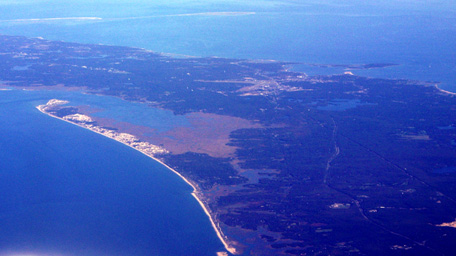
Who could afford Leopold's ethics?We are all just a separate cog in an ecological mechanism
In the disappearance of marshes, Leopold understood a deeper loss.
TVA , saw rivers as valuable for what they transport, falling water.
Flood Control was the preeminent reason for federal interest in Comprehensive Riverine Management.
Conservation as a means of relegating costly actions to government will fail
Leopold's ecological credo required protection of all parts of the ecosystem.
discovery of the complexity of the land mechanism, is the great achievement of this century.
marginal value of land runs counter to ecological values.
Local government dependence on property taxes works to destroy marshes.
"Land-use ethics is still dominated by economic self-interest."
Ezekiel & Isaiah
"I am glad I shall never be young without wild country to be young in."
page, 133."islands of diversity amidst a sea of sameness ... meant a dedication to landscape renewal."
Analysis | Introduction | 1 | 2 | 3 | 4 | 5 | 6 | 7 | 8 | 9 | Themes | Thesis | Vocabulary | Dates
7. Estuaries and The New Ecology
"The expansion of wisdom is a difficult task for an individual,
let alone a society. In
democratic cultures wisdom often may be overlooked at The voting boot in The
formulation of policy. For citizens and civil servants alike, confronting popular
notions of efficacy and justice takes courage. Rachel Louise Carson was an advocate
of unpopular causes, including fish and bird protection, preservation of wild
seashores, and opposition to heedless use of 'miracle' technologies. Her final,
best known attack on The indiscriminate uses of DDT as an insecticide was only
one part of her larger and more positive view of The world and humanity's place
in The eco-energetic scheme.... More than any other scientist she popularized
The oceans and The shores, with a profoundly religious respect for nature and
a practical appreciation for human ignorance. A contemporary of her fellow preservation
ecologist, Aldo Leopold, Carson focused more explicitly than he on oceans and
shores."
Land Ethic
PlanningWater
city or urban
Key Players
Review of Chapter Seven's main points:
Rachel Carson's tradition 1937-1668.
Popularization of the Sea before and especially after the warCity Planning and scenic preservation in 1920sMay 27, 1927, Rachel Carson was born in Springdale ,Pa.
1936 article in the Baltimore Sun on the Chesapeake Bay
Fish and Wildlife Coordination Act of 1934 to remedy single factor planning perspectives.
Federal Conservation Policy reformulation from Hoover to Hickeys and river protectionThe Sea Around Us (1951)Carson's books
Carson in the US Fish and Wildlife Service
"takes away a land suitable for wildlife" she argued as cities and highways were built and marshes were destroyed in the process.
Osborn, Brown and Commoner all stake out ecological problems due to population, resources and technology as causal factors.
National Book AwardEdge of the Sea (1955)
tideland habitats and their creatures
Place of our ancestral beginnings
A sense of wonder for seashore life
"essential unity that binds life to the earth"
Basis of the marine food chain: dinoflagellates, diatoms and copepods: the plankton.
Oysters and filter feeders"awareness of its beauty, and its deeper meanings, sensing the intricate fabric of life where one creature is linked to another and each with its surroundings."
page, 142.Eugene Odum's work (1954) in the Georgia Sea Islands."arteries of a remarkable energy absorbing natural system whose heart was the pumping action of the tides"
Between Pacific Tides, Ed Ricketts, John Steinbeck and the Monterey Bay fisheriesTies Lindeman's study to marsh grass productivity and Odum's rationaleShipworms and San Francisco Bay water quality changes
Water content of the hydrological system
water quality decline threatened estuaries nationally
Comprehensive Planning themeSpartina grass, mud algae, diatoms and the productive base of tidal marshes
What accounts for productivity of wetlands?
The fertility of tidal seas is unsurpassed due to animals and plants found nowhere else. These bacterial life forms called "protoctista" are able to live in either oxygen abundant (Oxic) or oxygen scarce (Anoxic) situations and some thrive under both conditions. This area shown in the animation on above is an important edge where one significant component of seaside production is apparent. This productive zone, deeper in the muds and sand flats, is a source of the prolific life that thrives in coastal marshes.
The ocean's temperate conditions, a coastal edge effect, and abundant nutrients are a triad of conditions contributing to the productive potential of this seaside nursery.
The economic returns from and thus the marginal utility of a corn field is greater than an estuary –but an estuarine marsh is biologically greater in productivity than is farmland. The reason why this is not evident is because in estuarine marshes where the yield is measured in terms of fish caught along the shore, or offshore, or out at sea– but not by the land owner of the marsh. Productivity of estuaries is harvested by the fisher, the fisher's family or the canneries that process the fish, not by the marsh owner. The fisheries, such as salmon, shrimp or blue crab, clams, tarpon or oysters, all depend on the healthy functioning of clean and relatively undisturbed estuaries where coastal marshes help to nourish young fish, shrimps, crabs and mollusks. Many if not all of these fish are caught away from their nursing grounds along the shore.page, 146.
Problems of the merely agronomic approach to marshes is similar to one dimensional planning. That means that by looking at only one measure of production and ignoring the rest of the data, conversion of wetlands to dry farm lands may appear economical, although reclaimed land may be more costly than leaving it as wetlands, especially in coastal salt-marsh dominated wetlands.
Need for coastal restoration districts based on the Soil Conservation District concept.
regional planning strengths and weaknesses
Planning movement, cities and transportation
Philadelphia transportation plan: PenJerDel
Suburban growth --as pictured here in the San Fernando Valley, just 20 miles from the coastline-- was enabled by the diversion of fresh water from estuaries and the progressive belief that home ownership was a strengthening element in post World War One America.
As the expansion of automobile roads and railway lines spurred the rapid development f land into suburbs, several cities began to become interested and promote regional planning.
Henry Wright -- NY State Commissioner of Housing define planning's goal
so that "economic gain may not involve inevitable social loss." (Pinchot),
balance country and urban influences by retaining the best of both.
page, 149.
As "any geographic area that possesses a certain unity of climate, soil, vegetation, industry, and culture."Emergence from the ecological revolt of the Gospel of Ecology, New Conservation, or New Ecology 1959-1964.Defined in order that planners may see "that population is distributed" he said "to utilize, rather than to nullify or destroy its [the regions'] natural advantages."
Regional Planning Association of America
New York City Metropolitan Plan Harold Ickes, Secretary of the Interior, & the New Deal Programs of PWA & WPA
National Planning Board's short lived history
1938 Monterey County Zoning Board's scenic preservation zoning upheld in court.

Human psychic need to identify with its surrounding land and water
sense of geological history to human endeavors
Carson's Silent Spring (1961 -1962)
Dying of cancer she visited Mount Desert IslandEcological values:April 14, 1964, Rachel Carson died (Silver Spring, Maryland.) -- the end "that intangible cycle"
Popularization of the marsh / tidelands message
"the articulation of an Estuarine preservation ideal" because the estuary is a "keystone for marine life"
Economic values:
Value of marshes for sanitation alone (1960s) was over $50,000 per acre in cultural replacement of the natural function.
Analysis | Introduction | 1 | 2 | 3 | 4 | 5 | 6 | 7 | 8 | 9 | Themes | Thesis | Vocabulary | Dates
8. Politics and The Preservation of Estuaries
"The pejorative implications of the words morass, slough, muck and miasma still associated with wetlands need no comment, these terms are common synonyms for obstruction, nuisance and disease. Yet as part of the national 'battle to preserve the common estate,' coastal marshes and tidal flats became The focus of a major drive for the protection of natural resources during The late 1950s."
Key Players
Review of Chapter Eight's main points:
National Battle to preserve the common estate
"The first principle of conservation is development," G. Pinchot (Chief forester of US)Many estuaries were the places where the nation was growing the fastest.denying the individual the right to harm the public or damage public good
preservation of wildlife habitat and scenic beauty
ecocentric approach to protection, LBJ called, the "new conservation," in 2-8-1965, speech
Average density of the US versus coastal areas where density increased sharplyBranches of government supportAnne Simon, 53% of the nation lived near the lakes or seashores
Southern California and Chesapeake Bay density comparisons from 3980 to 940 persons/ square mile
per capita demands for water and resources by industrial consumption
recreational demand
fixed tax base
increase in uses of cement
electricity and power plant siting near water
water quality decline
Stewart Udall's The Quiet Crisis, Secretary of the Interior, from Arizona 1961-68.National backgroundThree waves of conservation reform, were distinguished:Congressional support in Senate and House
- Theodore Roosevelt, Gifford Pinchot & W. J. McGee: "conservation" as to stop wasting scarce resources and apply wise use for the benefit of all.
- Franklin Roosevelt, Harold Ickes: Soil, water, flood control, fishery & wildlife protection based on comprehensive planning among agencies.
- John Kennedy and Lyndon Johnson the ecological perspective used to balance the clash between preservation (19th Century) and conservation (20th Century).
Supreme Court decisions
Justice William O. Douglas on planning and zoning, support for
Douglas call for "A Wilderness Bill of Rights"
The vague notion of an estuarine preservation ideal was being translated into policies and needed laws to protect and balance competing interests in the coastal zones all across the nation's more densely settled coastal cities.Regional needs from West, East and Gulf coasts were similar
California and especially along the Bay Area of San Francisco transportation planning triggered regional concerns when local preservationists realized the Army Corps of Engineers had plans to fill in 75% to 80% of the remaining bay bottom and adjacent wetlands.
Legislative historyABAG, Association of Bay Area Governments
Army Corps of Engineers and filling in of San Francisco Bay
Bodega Bay and the nuclear plant proposal on the San Andreas fault zone
Save San Francisco Bay Association
Corps violated the Fish and Wildlife Coordination Act of 1934
The map (at left) shows the extensive areas remaining today along the bay where tidelands were retained as marshes, mud flats, or oyster bars, for fisheries and birding areas. These extensive bay bottom and marsh lands were once slated to become marinas, developed lots and commercial real estate, as had been the custom in San Francisco since 1848.
State legislators were pressured to create a regional planning body: The Bay Conservation and Development Commission, (BCDC) for all of San Francisco bay's surrounding counties in June 1965.
The counties were included in this agreement as follows:
- San Francisco, oldest settlement, 1800s.
- San Mateo (Palo Alto), Stanford
- Santa Clara (San Jose), silicon valley
- Alameda (Oakland), largest container port
- Contra Costa (Concord - exurbs),
- Solano, vast marshes for bird migration & elk relocation
- Napa, river and riparian marshlands (Naval shipyard)
- Sonoma, (exurbs)
- Marin (suburbs) Muir Woods.
In 1970, Proposition 20, called for amending the State Constitution to allow for Coastal Protection of all the areas along the California shoreline to balance commercial, scenic and ecological values in an effort to afford access to the coast by citizens and continuing productive use of marine resources by commercial, sport and subsistence users.
Boston and Chesapeake Bay parallel development1952 Conservation Department of the State of NYCarson's Silent SpringCrisis of Long Island wetlands and coastal dredge and fill operations
Oyster Bay, Town of Hempstead. 29% of LI wetlands were lost in 10 years (1954-64)
New York City flight to suburbs, Nassau county tripled in population in 30 years
Affects of toxic DDT in Long Island Marshes, George Woodwell
Storm King Electrical Facility & Indian Point nuclear plant both were on the Hudson River and the reactor was near the river's spawning grounds of striped bass, a popular food and sport fishery whose species were dependent on the estuary, especially the mixing zones to nourish small, newly born fish.
and the fight against filling of Great South Bay, 1963-1965.1955 USDA had declared the "year of wetlands" raised awareness about need to buy fish and bird habitat, pursuant to federal treaties and laws (Lacey Act)1966 a bill was introduced in Congress to expand comprehensive planning in coastal areas
Massachusetts interests entered the array of supporters as the 1966 bill was defeated
In 1965, Governor John Volpe of Mass. expanded DNR permitting to protect 45,000 acres of coastal marshes in that state.
Takings issue explained. the use of private land for public purposes and reasonable compensation based on the the fifth amendment.
Northern California citizen pressure
Fish and Wildlife Coordination Act of 1934
amended in 1946
Congressional action for water quality
1948 and 1956 precedents in assisting local governments in making water purity a national matter
Water Quality Act of 1965, water pollution was accepted as a federal problem to be dealt with nationally
By 1960 NY State provided grants to Long Island to purchase wetlands.
Federal support for regional and comprehensive planning in 1962
NOAA, 1970 and the Intergovernmental Coordination Act of 1968
Land and Water Conservation Fund, 1964, was a novel means of funding recreation purchases
Federal desire to balance development and coordinate the bureaucracy
Congressional intent appeared to be moving in the direction of coastal conservation
1965 Rep. Tenzer introduced Long Island Wetland Protection billJoint federal-state systems of Estuarine Management areas was also envisioned.1966 version of the bill favored by the Administration and Chairman Dingell would have given the Secretary of the Interior control over Dredge and Fill Permits, instead of Army Corps of Engineers.
Dingell-Kennedy Bill was defeated in the House by three votes on 10-3-1966.
Alabama, Mississippi, & Virginia Congressional delegations were opposed.
Absenteeism was a factor as was Republican opposition which spearheaded the defeat.
1967 the bill was re-introduced in the House.
1968 A Senate version of the bill was accepted by the House.
Opposition was from The Army Corps of Engineers over the dual permitting system envisioned by the legislation
Great Lakes were included to build support for the bill.
Summer 1967 Stewart Udall and ACE signed an MOU on the permit issuance controversy.
New version of the Bill in 1968 had support of House and Warren Magnuson in the Senate.
August 3, 1968 a weaker bill emerged as law, mandating a national estuarine sanctuary program
"every bit as much a part of our natural heritage as are mountains and great rivers." Edward Kennedy
Need for cooperation among local, state and federal authorities to protect entire coastal wetland ecosystems.estuaries and their biotic wealth were popularized by books and mediaLegally defined estuarine marshes eligible for protection
Tri-level planning to protect coastal resources was a forerunner of NEPA and CZM Act
1970 ruling on Boca Ciega Bay filling in Pinellas County, Fla. reflected the new status.
Between the Devil and the Deep Blue Bay, Harold Gilliam
Critics of marshland preservation as a waste of waste lands
Criticism of the Acts weakness, thus more an intent and a sentiment than a mandate.
ad valorem taxation problem for strapped municipalities
equity in cost sharing of protecting common resources
wildlife protection required land and water acquisition
recreation access often was counter to protection
Tragedy of the Commons problem of common property resources with private profiteering at a cost to the public
Several commons intersect in the estuary -- an edge effect for
biotic integrity clashed with layered common property resources such as fish,
birds, recreation and water quality.
Coercion and mutually agreed upon controls involve watching of agencies to protect coastal zones.
Section §404 of the Clean Water Act, narrowly read by ACE to allow upland fill at the owners discretion would undermine estuarine integrity.Challenges of estuarine protection on a national scale, represented a change despite the lack of funding and enforcementTidelands require water and land protection together, not merely one to the detriment of the other.
Polluted water undermines the land's integrity, health and functionality.
Analysis | Introduction | 1 | 2 | 3 | 4 | 5 | 6 | 7 | 8 | 9 | Themes | Thesis | Vocabulary | Dates
9. Americans and The Tidal Seas
"As The American nation has grown older, its attitudes toward its natural resources have changed and matured. Its legal underpinnings for environmental policies have been reinterpreted and reformulated to accommodate The changing understandings and values. The estuarine preservation ideal that emerged in The mid- to late 1960s is one of The most recent developments in American ideas concerning resource stewardship."
Review of Chapter Nine's main points:
resource stewardship, an example in the National Estuary Protection Act
"estuaries are an integral part of the earth's ecology" 188
coevolution and biotic integrity means that natural capital accumulates over time like money in a bank, and thus Leopold saw in a crane marsh a paleontological place where birds had found refuge and thus marshes that remained today were a phylogenetic savings account of unsurpassed value.
mature view of humans and estuaries as an unfinished process
critics of preservation argue we place wilderness ahead of human needs
economic and libertarian arguments persist to challenge the coast protection consensus
landscape alone is not sufficient for protection since water and nutrients that feed the system are equally important to protect. Water quality then flowing over land or through landscape is equally important to protect.
crib of the future, evolutionary reminder of our past and dim beginnings, 190
Charles Lindbergh and the "qualities of our planet's life."
democratic values and conservation ideals are inherent in restoration choices we are making
essence of the ancient public trust. 191
untamed beauty and wide expanse
"In these coastal regions where American civilization has tread most heavily, wild marshes hold a special appeal.
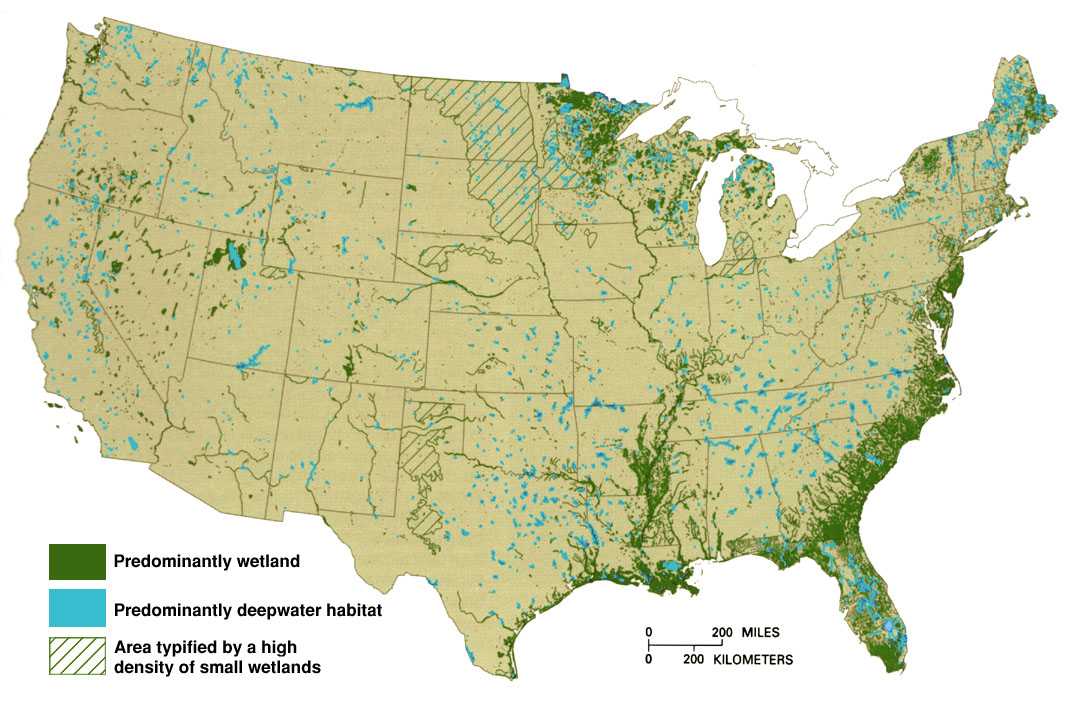
The location of estuarine, freshwater, salt marsh, brackish, and interior wetlands in the lower 48 states of the United States.
Maps:
| Boston | New York City | Connecticut River Valley | San Francisco |
"..a haunting refrain in the never ending yet urgent search for humans to find their identity in relation to natural landscapes."
"we are the current caretakers of a delicately coevolved maritime garden whose produce must always we thoughtfully harvested."
Estuaries as an inherent place of conflicting values
Themes
|| Thesis | Dates || Terms

Chicago River
Themes
| Technology | Population | Preservation | geographical regeneration | Law |
Each age or period defines natural features, economic value and laws differently depending on their technological capacity and knowledge of their surroundings.
There is a legacy in American, English and Roman legal theory, or jurisprudence that articulated a perpetual public interest in certain landscape features based on their character, geography, topography and functional processes.
Geographical information grew slowly in America, but was seen from the time of colonial settlement and later by John Quincy Adams as an overriding responsibility of a central government to provide society with adequate surveys, maps, topographical and bathymetric information and the location of useful resources.

Technology is a two-edged sword allowing for the accumulation of knowledge and expanding the capacity to alter our surroundings to better suit human demands, both material and spiritual.
Science, or the knowledge of physical, chemical, geological and biological information about The universe, has The capacity to alter our sensitivities to The world around us.
Population growth, transportation demands, increasing wealth and the demand for a greater variety of leisure activities all converged after world war two placing unusually sharp and conflicting demands on limited coastal, river and natural resources.
Despite what some historians have suggested concerning, the origins of conservation emerging from a concern for parks, forests and agriculture, there is evidence to show that fisheries, wildlife and river pollution as these affected human health and urban development were equally old sources of the impulse to protect natural areas from damaging intrusions.
Preservation
of cultural and natural resources predated the rise of conservation in North
America. Conservation arose late in The 19th century
and referred to both a keeping from harm and the wise use of natural resources
for the long-term and most beneficial uses by a majority of the population.
Preservation of valued naturally significant or culturally memorable places
can be dated to before The Civil War.
In both the redesign of urban landscapes and the necessity of controlling rivers along an entire watershed, the emergence before the civil war of a practice restoring natural harmonies arose and was later characterized as "geographical regeneration," by G. P. Marsh.
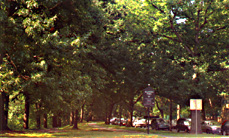

Frederick Law Olmsted Sr.'s "Emerald Necklace," Boston Regional Park plan
| Introduction | 1 | 2 | 3 | 4 | 5 | 6 | 7 | 8 | 9 | Themes | Thesis | Vocabulary | Seagrass |
Thesis

View of Delft, Vermeer, 1658-60.

Legislative History Dates
1948, precedents in making water purity a national matter
1952, Conservation Department of the State of NY
1955, USDA had declared the "year of wetlands" raised awareness
about need to buy fish and bird habitat, pursuant to federal treaties (Migratory
Bird Treaty) and laws (the Act)
1956, precedents in assisting local governments in making water purity a national
1964, Land and Water Conservation Fund established
1965, Rep. Tenzer introduced Long Island Wetland Protection bill
Bolsa
Chica wetland pictured here in Costa Mesa, in Orange County, California were
half the original acreage of the marshlands were drained and filled to provide
for real estate development in the form of single-family homes. Such development
was typical of coastal areas, before Congressional action and even after.
1966, a bill was introduced in Congress to expand comprehensive
planning in coastal areas
1966, version of the bill favored by the Administration and Chairman Dingell would have given the Secretary of the Interior control over Dredge and Fill Permits, instead of Army Corps of Engineers.
1967, the bill was reintroduced in the House.
1968, A Senate version of the bill was accepted by the House.
1968, August 3, passage of the National Estuary Protection Act.
1970, ruling on Boca Ciega Bay filling in Pinellas County, Fla. reflected the new status.
1970, Proposition 20, called for amending the State Constitution
to allow for Coastal Protection
| Introduction | 1 | 2 | 3 | 4 | 5 | 6 | 7 | 8 | 9 | Themes | Thesis | Vocabulary |
Links: